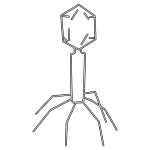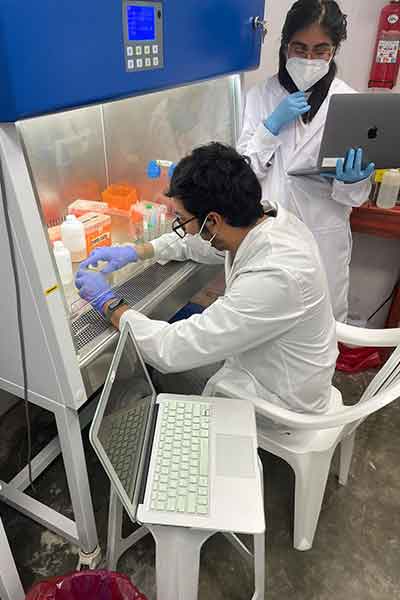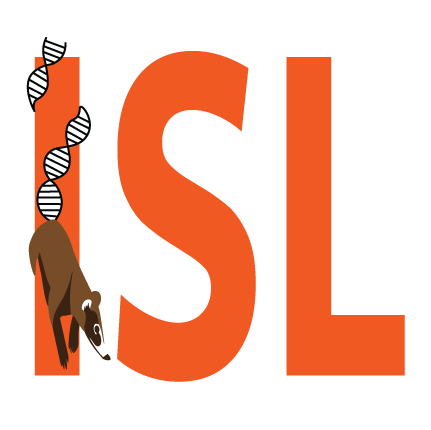OPERATIONS & OVERSIGHT
Biosafety
A good lab is a safe lab.
NOTE TO TEAM –

look out for this.

and this

There are several materials in the laboratory that enhance safety features:
- A fire extinguisher for class ABC fires for each isolated laboratory space, and especially in rooms that have major heating elements (i.e. ovens and autoclaves). Consider also providing your teams with training in the same, since many people have not had fire-safety experience.
- First aid kit should be kept in the General Laboratory Space
- A chemical spill kit should be kept in the General Laboratory Space
- An eye wash station or device must be placed within reach of the laboratory, ideally near the wash sink
- An emergency shower should be in or near the main laboratory space
- Signage
- No food no drink signs on all freezers and refrigerators
- BSL level classification sign on entrance to main laboratory
- Biohazard signs on appropriate waste bins
Note: these are basic recommendations that do not replace consultation with a facility safety professional
The BLUEBOOK is a basic and essential requirement for all laboratories. It is usually a large binder (traditionally BLUE in color) with comprehensive documentation for the facility (including but not limited to topics on facility usage, security, BSL classification, upkeep, training requirements, safety, etc.).
- The book exists in physical form in the laboratory for anyone to review (technicians, researchers, inspectors) as required.
- In the case of a mobile laboratory (SEE levels 1 and 2), a bluebook should still be kept available at all times (i.e. in digital form).
- In situ laboratories, in particular, operate in ways different from traditional urban laboratories, and hence the bluebook should be modified to match. For example, urban laboratories rarely have a section on ENERGY SYSTEM USE, and ISL facilities may have different sterility and contamination avoidance procedures due to their close proximity to natural environments.
A generic bluebook may be downloaded HERE. IMPORTANT, this is provided as an example / starter document that contains some text that is ONLY meaningful to the laboratory that created it. It should not be used verbatim, and we do not validate Blue Books for any laboratory.
LABORATORY BLUE BOOK STANDARD COMPONENTS
- PURPOSE
- BIOSAFETY LEVEL CLASSIFICATION
- LABORATORY OVERSIGHT and PERSONNEL
- DESIGNATED SPACES
- Space 1
- Space 2
- Space 3
- EQUIPMENTS & STANDARD OPERATING PROCEDURES (SOPs)
- CHEMICALS AND COMPOUNDS LIST & USES
- WASTE MANAGEMENT
- Types
- Disposal
- LABORATORY ACCESS
- LABORATORY SPECIFIC TRAINING REQUIREMENT
- SAFETY EQUIPMENT & EMERGENCY PROCEDURES
- ENERGY USE & SYSTEMS MAINTENANCE
- SAFETY DATA SHEETS


Example Charter with suggestions and comments inside brackets [ ]. Note, there are many ways to design a charter. This is merely a template that can burrowed as may be applicable.
Upon execution of this MOU, the COMMITTEE will hold [defined a frequency that works for your teams – it can change over time] meetings beginning in YEAR for the duration of this agreement. Meetings will be held [pick a platform best for your team; in person, virtual, combo, etc] to discuss and conduct activities required by the laboratory ( – consider adding in exhibitions after the agreement to highlight various areas of focus, such as roles, activities, timelines . A standardized meeting template will be established collaboratively by the COMMITTEE once active. The frequency of meetings may be changed in writing with the mutual agreement of all COMMITTEE members.
One person from each of the member organizations [DEFINE ORGS INVOLVED] will be the active participant (hereinafter “REPRESENTATIVE”) of the COMMITTEE. REPRESENTATIVES will create and adopt criteria for adding/replacing member organizations in the future. Member organizations are encouraged to select REPRESENTATIVES who possess a permanent or long-term role within their organization, and who have [DEFINE QUALITIES NEEDED FOR A SUCCESSFUL COMMITTEE SPECIFIC TO YOUR PROJECT – an example is “a scientific background, especially laboratory training where possible”. The expected service commitment for a REPRESENTATIVE is [pick a frequency]. The REPRESENTATIVE of each member organization may change within the [time period you have agreed on] period, however, several months’ notice should be given before the change becomes effective if possible.
- Propose policies for the proper operation of the laboratory to [organization(s) maintaining laboratory] , including but not limited to:
- Waste disposal
- Safety
- Training requirements for personnel hired for the laboratory
- Permitted/prohibited laboratory procedures
- Access for researchers and educators
- Laboratory use rates and applicability
- Promote compliance with national laboratory regulations.
- Formulate and propose a Laboratory Financial Sustainability Plan, and actively contribute to its implementation after approval. This plan will consider, among other things:
- [LABORATORY NAME] operating costs
- a) Cleaning of the facilities
- b) Facilities maintenance
- c) Basic equipment upgrades/replacements
- d) Utility costs (power/water/internet), if applicable.
- e) Other direct expenses (supplies and delivery, technical and maintenance services, consultant for electrical system maintenance, etc.)
- Year-round staffing : technical and maintenance personnel
- Grant opportunities for infrastructure improvements.
- Fee structure for use of the molecular laboratory, bench space, or equipment by third
parties, if desired.
- Fee structure for use of shared supplies of a shared nature that are unique to the [LABORATORY NAME], as appropriate.
- Suggest personnel to hire and report on the performance of [LABORATORY NAME]molecular laboratory technicians/managers. Laboratory technicians and managers may be suggested and/or provided by any member organization of the COMMITTEE, but their roles and responsibilities will be coordinated jointly by the COMMITTEE. The decision to change or remove personnel is the responsibility of [organization(s) responsible for maintaining the laboratory], which will follow the corresponding administrative procedures of law in these cases.
- Conduct timely review and processing of all third party requests for use of molecular laboratory space.
- Propose procedures to be followed for access to the molecular laboratory by third parties, including: requirements, application evaluation system, scheduling, etc.
- Evaluate supply lists in conjunction with laboratory staff to ensure that reagents and supplies are carefully tracked. This is to ensure an up-to-date inventory of supplies, as well as the ability to charge others for the use of any shared supplies in a standardized manner (e.g., pipette tips or other consumables that are unique to the laboratory).
- Monthly review of the condition of the molecular laboratory equipment and infrastructure, which will be coordinated and reported with the [organization(s) responsible for maintaining the laboratory] administrative area. In case of infrastructure or equipment breakage, it will be discussed how the item can be fixed, who should take ownership and how/when the repair or replacement is carried out. Any change of equipment or infrastructure must be approved by [organization(s) responsible for maintaining the laboratory].
- Develop and propose to [organization(s) responsible for maintaining the laboratory] a policy and procedure for tracking the use of [LABORATORY NAME] specific shared laboratory supplies and a system for obtaining these items locally or through international coordination as needed. [organization(s) responsible for maintaining the laboratory] will, in turn, enable an avenue for third party fee collection to stock/replace lab supplies for project use.
Contribute to the maintenance of a web page on [insert website link] that can be embedded or linked or shared on all member websites if they so choose. The site will include lab policies and the procedure for submitting a request for lab use. This helps with defining roles to outside organizations who are interested in understanding how the collaboration is organized.
Unless otherwise noted, more than one member of the COMMITTEE may collaborate in the performance of special roles. There are also non-delegable functions that must be performed by [organization(s) responsible for maintaining the laboratory] as the owner of the laboratory including personnel contracts/dismissals, modification of infrastructure, control of fundamental laboratory assets (equipment) and others.
- CHAIRPERSON: This person is responsible for arranging meetings of the committee members and setting the agenda for the meetings. This role may be self-appointed, no term is required for this role, and a new Chair may be nominated at any time by any committee member. The Chairperson is determined by a simple vote among all active committee members, and there can only be one Chairperson at any time.
- SECRETARY: Shall be responsible for documenting COMMITTEE meetings. This role may be self-appointed, there is no required duration for this role, and a Secretary may be nominated at any time by any committee member. The Secretary is determined by a simple vote among all REPRESENTATIVES, and there can only be one Secretary at any one time. Notes must be deposited in a shared online folder accessible to all other REPRESENTATIVES. In addition, non-members of the COMMITTEE may attend monthly meetings in order to assist in taking notes in both English and Spanish, but the Secretary remains responsible for ensuring that notes are clear, complete, and deposited in a shared online repository.
- THIRD PARTY COORDINATOR: Shall be responsible for overseeing requests for third party access to the laboratories, ensuring that requests are reviewed by the COMMITTEE on a monthly basis, and issuing letters of “support and approval” or “rejection” once the review process has been completed. The role of the third party coordinator(s) will be discussed by the COMMITTEE and then appointed by the CHAIRPERSON. There may be one or more persons serving as Third Party Coordinator(s). The Third Party Coordinator need not be a REPRESENTATIVE, but should belong to a member organization and report their activity directly to the COMMITTEE.
- INVENTORY COORDINATOR: One or more committee member(s) will be responsible
for coordinating with laboratory staff to keep the molecular laboratory supply list up to date, and for approving and overseeing third party access to shared supplies. COMMITTEE members with active laboratory projects will be best suited for this role. The Inventory Coordinator role will be discussed by the COMMITTEE and then appointed by the CHAIRPERSON. There may be one or more persons serving as Inventory Coordinator(s). The Inventory Coordinator(s) need not be a REPRESENTATIVE, but should belong to a member organization and report their activity directly to the COMMITTEE.
Each Party shall decide and direct its own purchase and use of materials necessary to fulfill its responsibilities to the [LABORATORY NAME]. Ownership of any equipment purchased solely for the [LABORATORY NAME] will be transferred to [organization(s) responsible for maintaining the laboratory].
For the duration of this Agreement, the Parties agree to share resources, if reasonable and practical, toward fulfilling the scope of work (EXHIBIT A).
For all actions taken in association with the ACTIVITIES, including the handling of animals and collection of biological samples, operation of a molecular laboratory and management and disposal of hazardous waste, the PARTIES agree to comply with all pertinent ethical and safety standards to protect animal, environmental, and human health. This may involve, but are not limited to, reviewing and adhering to applicable biosecurity standards, COVID protocols, meeting institutional animal care and use expectations, meeting or exceeding waste disposal regulatory requirements, and maintaining any associated documentation.
By signing this document and formally joining the COMMITTEE, each Party affirms their commitment to the sustainable operation of the [LABORATORY NAME] molecular laboratory in support of scientific research, wildlife health monitoring, wildlife and habitat conservation, which are consistent with the formation of the[LABORATORY NAME] (refer to SECTION 2 “PURPOSE”). In good faith, all member organizations commit to contribute financial and/or in-kind and/or intellectual and/or employee resources for the sustainable use, operation and governance of the [LABORATORY NAME]. This document does not create financial commitments or obligations among member organizations. The financial resources necessary to support the long-term sustainable use of the [LABORATORY NAME] Molecular Laboratory will be covered by the member organizations according to their budgetary availability or by external funding sources that have been previously or jointly coordinated.
Committee member organizations that already have, or that establish at a future date, a long-term commitment (financial or otherwise) to supply or staff/operate the [LABORATORY NAME] laboratory will be exempt from third-party laboratory use fees, and their research projects will have priority access to the molecular laboratory facilities. The projects of these committee members will be considered “INTERNAL” projects, as they are directly associated with the long-term sustainability plan (see EXHIBIT A, SECTION 3, PART C).
Once a year, the COMMITTEE shall review the [LABORATORY NAME] Advisory Committee Scope of Work (EXHIBIT A) and discuss whether it needs to be expanded or modified. If modifications are approved by unanimous agreement, an addendum shall be distributed for signature by a qualified representative of each member organization.
In addition to the aforementioned guidelines, each Party will undertake the following…
[Examples of EXHIBITS that could refer to one or more parties and based on the level of detail a laboratory needs]
- Scope of work
- Research in the Laboratory
- Committee Scope
- Laboratory Management plan
- List of expected activities at the laboratory (daily, weekly, monthly, yearly)
- Waste Management Plan
- Chemical Use Plan
- Energy Use Plan
- Bluebook reference
- Emergency Response Plan
- List of expected activities at the laboratory (daily, weekly, monthly, yearly)
- Sustainability
- Short-term sustainability plan
- Long-term sustainability plan
- Application for researchers to use the laboratory
- Application
- Review process
- Communication plan
